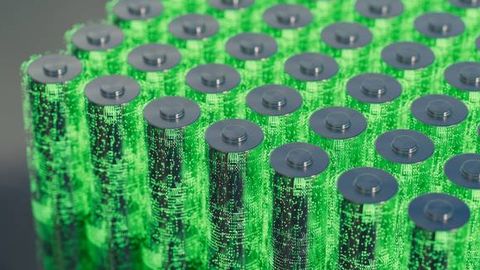The Importance of Battery Materials Analysis
To ensure battery safety and quality, rigorous analysis and quality control checks are essential.

Complete the form below to unlock access to ALL audio articles.
Battery power has become a keystone for so many modern technological advancements, from the cordless vacuum in your closet or hybrid car in your garage, to the phone in your pocket.
Against a backdrop of rapid growth in consumer demand for improved battery power systems, researchers and manufacturers alike are keenly aware of the need to study and improve upon current battery technologies. At the same time, it is vitally important that the batteries available on the market today are carefully scrutinized to ensure that they are safe for use.
Lithium-ion (Li-ion) batteries are at the forefront of the modern energy storage market, thanks to their high storage capacity and relatively low cost. With the ongoing commercialization of these batteries, it is important that they are able to demonstrate high levels of safety and efficiency before they end up in the hands of the consumer. If a fault is left unchecked, Li-ion battery failure can be disastrous, resulting in burns, fires and in some cases the leakage of harmful chemicals such as hydrofluoric acid.1
To ensure that batteries are fault-free and operating as intended, battery components require rigorous analysis and quality control checks involving a variety of analytical techniques. These same techniques can also be leveraged by scientists to study the internal workings of batteries, leading to the development of new, more optimized battery types suitable for a wide array of different energy storage applications.
Analysis throughout the battery lifecycle
A traditional Li-ion battery consists of a cathode, which is the source of the lithium ion, an anode, which stores and releases these lithium ions into an external circuit and an electrolyte, which allows ions to flow between the two. In a rechargeable Li-ion battery, the lithium ions flow towards the anode during charging, and their movement through the electrolyte and towards the cathode when discharging is what causes the release of energy.2
Rechargeable – also known as secondary – batteries can be tested at many points throughout their lifecycle. Systematic analysis of the raw materials being used in battery production can be very instructive, as this is when impurities or defects can be detected in a batch and removed from the production line.
At the end of a battery’s usable life, the battery components can be tested again to determine whether the materials are in a suitable condition to be recycled. For example, non-destructive imaging tests can rule out any lithium dendrite formation that could compromise the material.3,4 Similarly, forensic analytical testing can be done to identify the cause of a battery failure or to establish why battery performance might be declining at an unusually rapid rate.
Analyzing battery components within their natural lifespans is also particularly valuable to R&D scientists. Measuring the chemical state of the cathode, anode, electrolyte and any extra contact layers or additives at various states of charging and discharging can reveal valuable information relating to the electrochemical processes that are occurring inside these batteries. This can be used to inform further experiments aimed at improving battery efficiency.
Frequently used battery material analysis techniques
The anode in a Li-ion battery is typically made up of graphite, a binder and other conductive additives coated on copper foil. Graphite is key to the function of a good anode, due to its ability to reversibly place lithium ions between its many structural layers. Any impurities in this graphite can hamper the performance of a battery. As a result, it is important that the graphite stocks being used in battery production undergo impurity analysis. This is typically achieved using inductively coupled plasma-optical emission spectroscopy (ICP-OES).5
As the source of lithium ions in a Li-ion battery, the cathode can be made from a range of different lithium salts. There are currently two approved laboratory standards for the screening of impurities in battery lithium salts: the Chinese Standard GB/T-11064.16-2013 and the International Electrotechnical Commission (IEC) 62321.6,7 Both methods suggest the use of ICP-OES as the gold standard technique for this analysis.
There are many different types of electrolytes that can be used for battery production. Lithium hexafluorophosphate (LiPF6) is the most widely used salt for commercial Li-ion cells, which is mixed with an organic solvent to form the electrolyte.8 To improve electrolyte performance metrics, such as its chemical stability and ion transport properties, it is also common for other additives to be mixed in with the electrolyte.
Due to their chemical composition, such electrolytes can be very flammable. Even under normal operating conditions, batteries can produce heat that may trigger unwanted chemical reactions in the electrolyte or at the interfaces between the electrolyte and the cathode/anode.9 For this reason, thermogravimetric analysis (TGA) can be a valuable tool for assessing the thermal decomposition of various materials in Li-ion batteries.10
Damaged or very aged Li-ion batteries can also begin to produce dangerous volatile organic compounds such as dimethyl-2,5-dioxahexane dicarboxylate (DMDOHC) or organofluorophosphates (OFPs) and organophosphates (OPs) depending on their chemical makeup. If these volatile gases build up over time, it can cause a battery to swell and potentially lead to more catastrophic failure. Analysis of these volatile gases and thermal degradation products by gas chromatography-mass spectrometry (GC-MS) can help academics and R&D researchers to improve our understanding of the risk factors for these failures and inform strategies to mitigate them.10
In operando battery analysis
For academics and R&D researchers, techniques that enable the observation of what is happening inside a battery during its charging, operation and recharging cycles are the “holy grail” of battery analysis.
“What's really, really making a difference is being able to characterize in situ, or even better in operando,” said John Irvine, a professor of chemistry at the University of St Andrews.
“What we can do really well is characterize the materials that we put into the batteries. But like many electrochemical techniques, sometimes what you put in there has not got a lot of relevance to what's actually important,” Irvine explained. “After the first cycle, you could actually be looking at something totally different to what you started with. So that's where the in situ and in operando or even post-mortem [analysis] becomes much more useful.”
Over the past several decades, advances in synchrotron-based X-ray techniques have given researchers the right tools to be able to study the working mechanisms behind effective battery materials. Methods such as soft X-ray absorption spectroscopy (sXAS), hard X-ray absorption spectroscopy (XAS), scanning/transmission X-ray microscopy (STXM/TXM) and X-ray diffraction (XRD) effectively allow researchers to see inside the battery.11
With these methods, used in conjunction with other scattering, spectroscopy and imaging techniques, researchers can comprehensively analyze any changes occurring in the crystal structure, electronic structure, chemical composition and morphology of battery electrode materials.
Alternatives to lithium batteries
Li-ion batteries are the most widely-used battery type today for good reason – their electrical storage capacities are virtually unmatched. But that does not mean that they are necessarily the best choice to support future endeavors.
The production of Li-ion batteries requires the mining and transport of other metals, such as cobalt, which historically do not have the most stable supply chains.12 As a result, the investigation, analysis and development of alternative battery chemistries has become a key area of focus for many research groups.
“Sodium is [interesting] essentially because it's inexpensive and ubiquitous, as opposed to lithium, which is just concentrated in relatively few countries,” said Dr. Scott J. Lilley, project manager at the Faraday Institution’s NEXGENNA project – a research initiative uniting researchers from across the United Kingdom who are working to accelerate sodium battery development.
“It promises a cheap battery, a cheap, sustainable battery, so that's why it's interesting. The price you pay for that [is that] sodium is heavier [in terms of atomic weight], so you get less energy density. And so that's the challenge – we're working on ways of making sodium ion [batteries] as sustainable as possible, but also maximizing its energy density and its other properties for applications.”
One of the key areas of focus for sodium ion battery development that NEXGENNA is working on is the creation of new, more effective sodium salts. Unlike lithium batteries, which have a whole suite of salts to choose from, current options for sodium ion batteries are limited.
NEXGENNA are also involved in developing a toolbox of new analytical techniques for advanced battery characterization, with the intent of establishing best practices for analysis in battery research.
“We have a number of people that are developing analytical techniques, in situ or in operando for probing batteries,” Lilley said. “There's a group at Lancaster [University] looking at atomic force microscopy, so they are actually scanning the surfaces in the battery with a vibrating needle effectively, and quantifying the viscosity of the mechanical behaviors near the interfaces, which is important for sodium ion [batteries]. One of the things with sodium ion [batteries] as well is that the interfaces are less well understood than for lithium, so it's an important area to understand.”
“There's also Professor Clare Grey’s group up at [the University of] Cambridge who are doing some important stuff with solid-state [nuclear magnetic resonance] NMR,” Lilley added.
Collectively, the analysis of battery materials – whether this is done by a manufacturer for commercial purposes or academics for the purposes of learning more about how battery chemistries work – is helping to ensure that the batteries we have today are safe and effective in their use. Advanced analytical techniques are also setting the stage for revolutionary new developments in alternative battery science, which will help in powering our collective futures.






